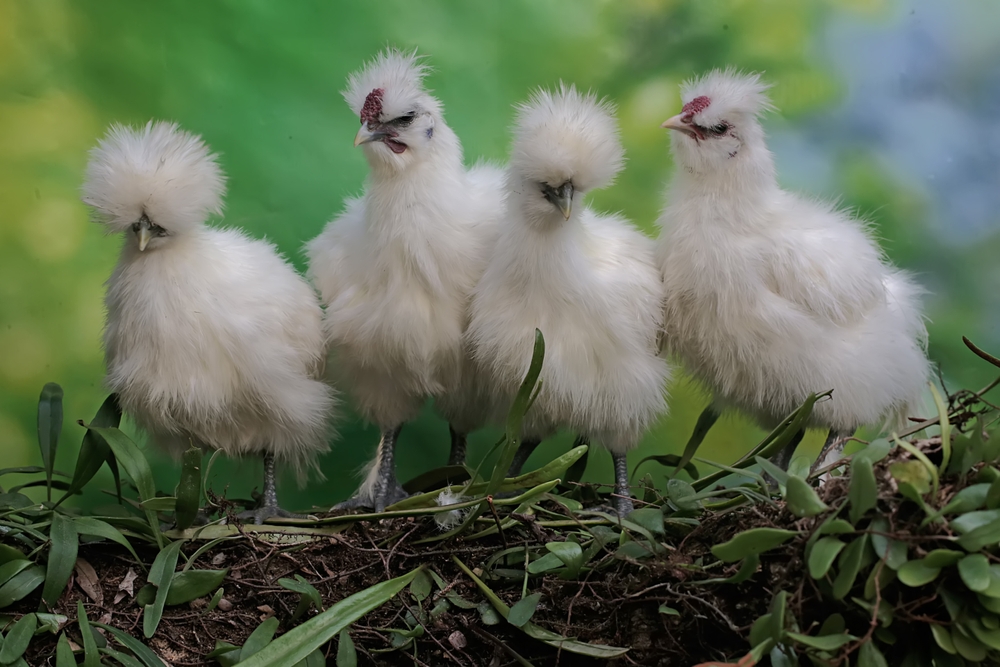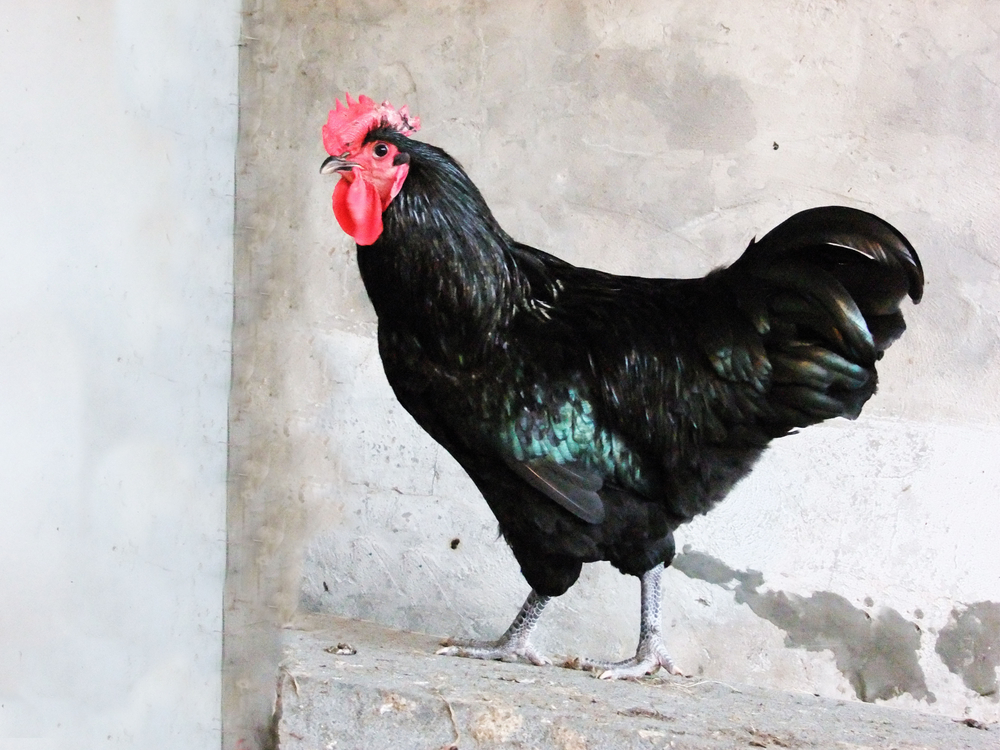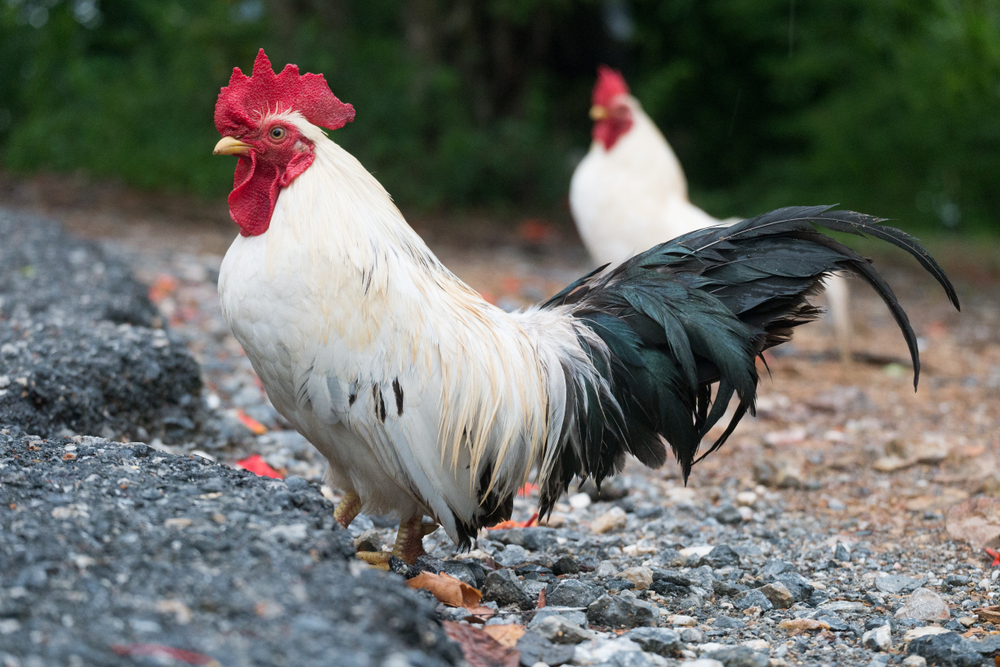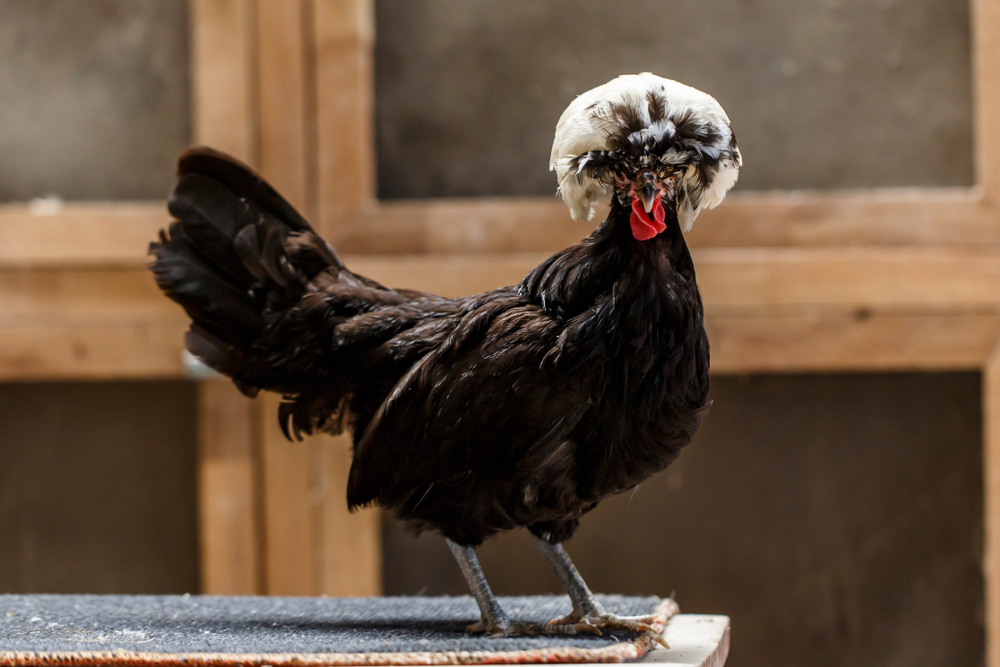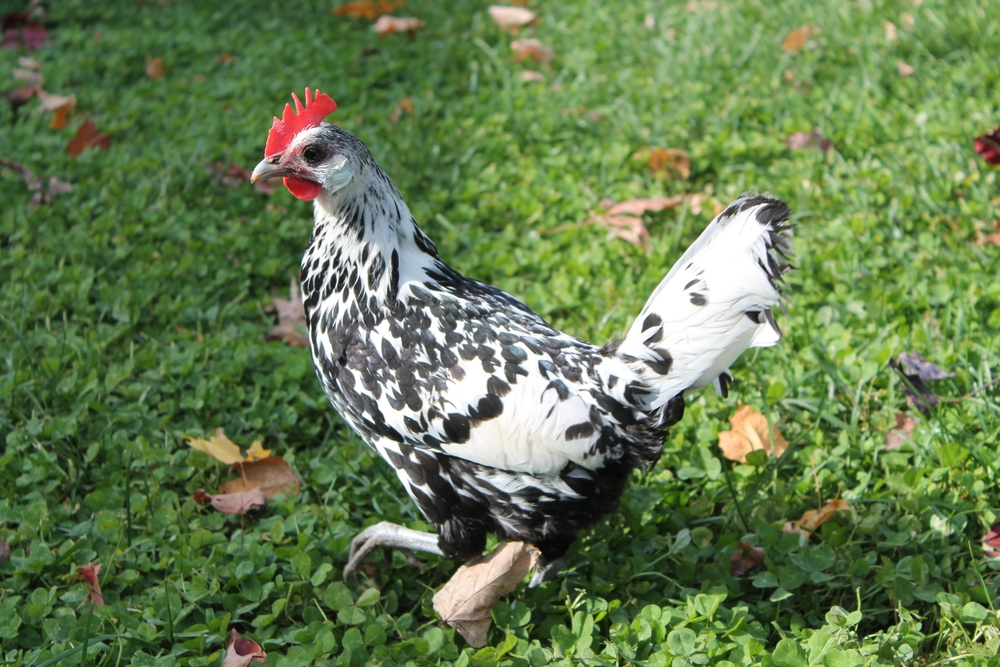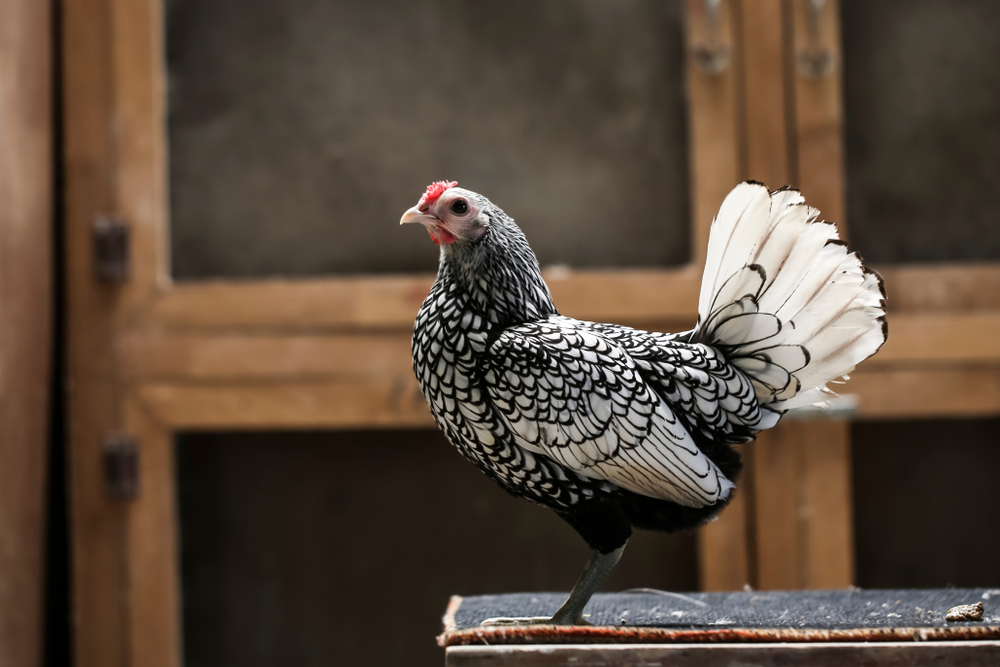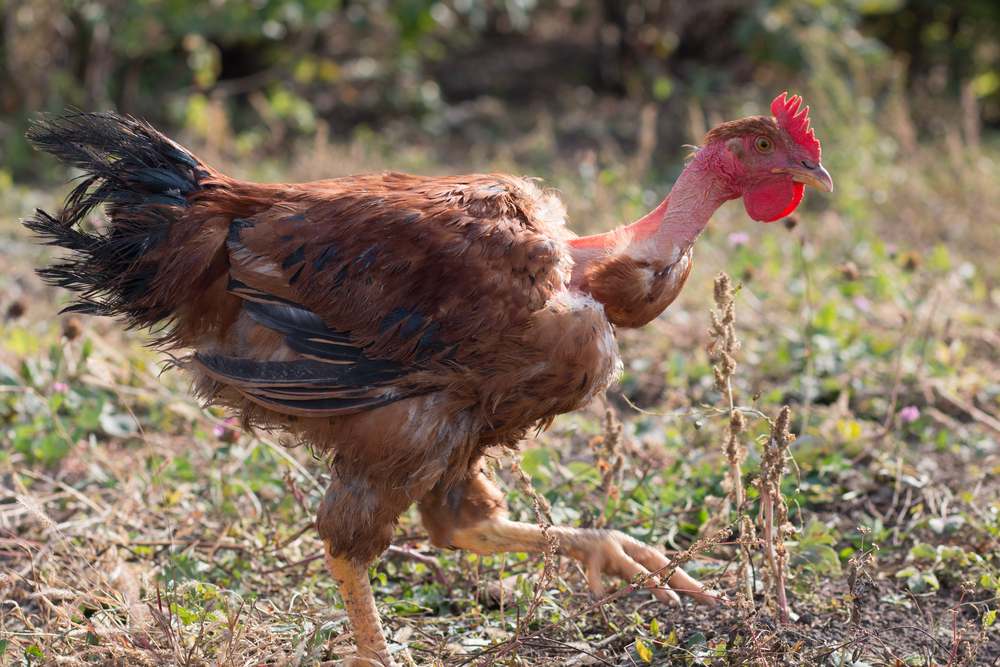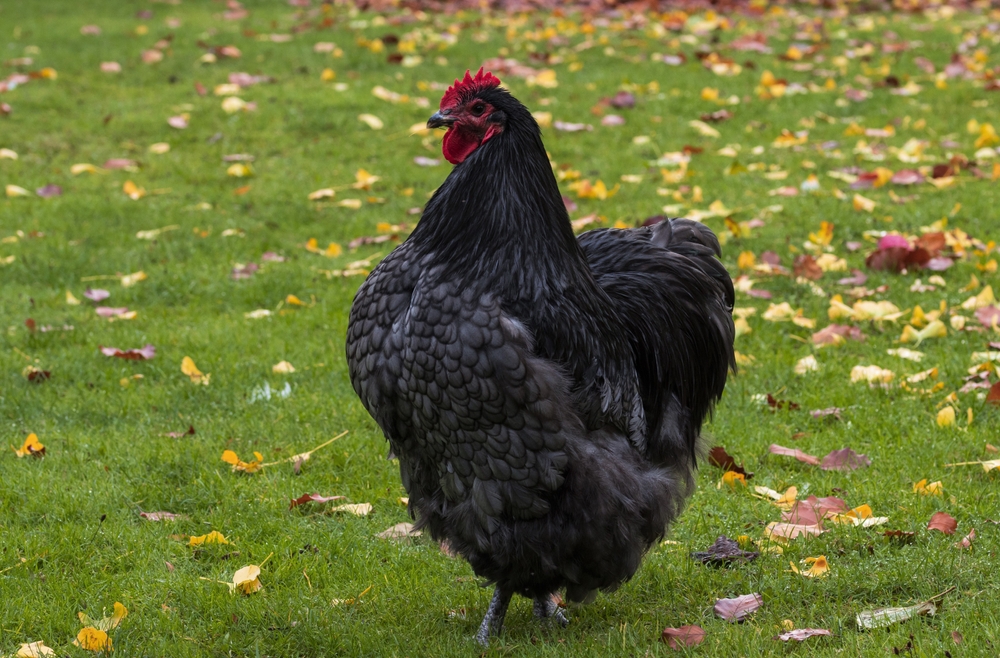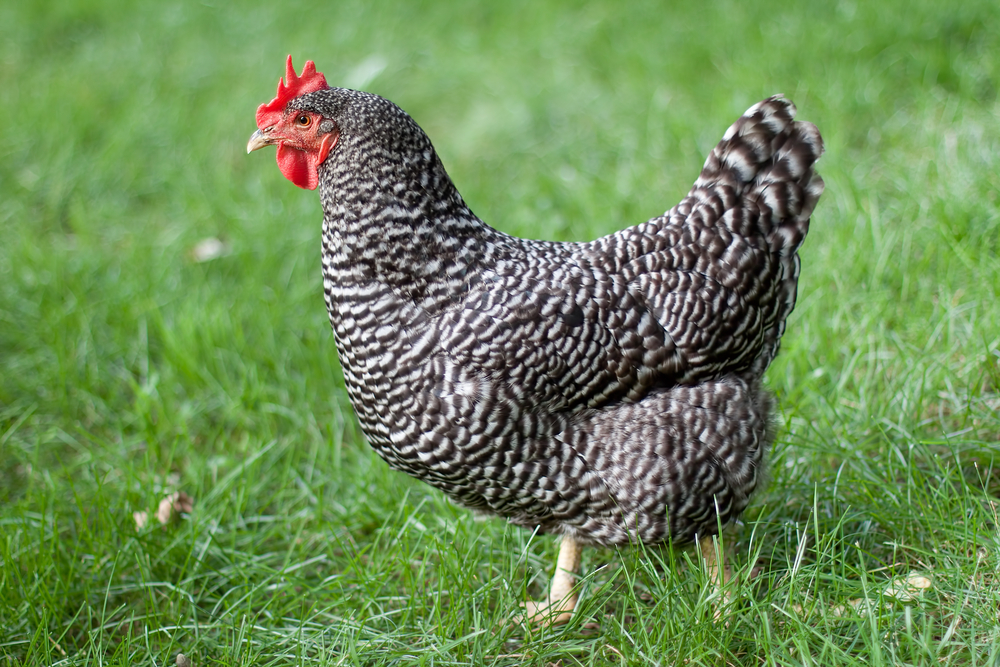The closest related breed to the Silkie is the Showgirl, a cross between a Silkie and a Naked Neck. Showgirls inherit the Silkie’s fluffy plumage, black skin, and five toes, but with the Naked Neck’s bare throat and upper crop, giving them an even more unusual appearance.
About
The Silkie is one of the most unique and recognizable chicken breeds in the world, famed for its soft, fluffy plumage that feels like silk or satin. Originating in Asia, likely China, Silkies have been documented for centuries, with references in the writings of Marco Polo in the 13th century. They were introduced to Europe via the Silk Road and quickly gained popularity as ornamental and companion birds.
Silkies are small to medium-sized, with roosters weighing around 1.8 kg (4 lbs) and hens about 1.4 kg (3 lbs). Their feathers lack functioning barbicels, preventing them from locking together like normal feathers, resulting in their downy appearance. They also have several other unusual traits, including black skin and bones, blue earlobes, and five toes on each foot instead of the usual four.
They come in a variety of colors, including white, black, blue, buff, partridge, and splash. Silkies have a crest of fluffy feathers on the head, a walnut-shaped comb, and feathered legs and feet, adding to their ornamental appeal.
Silkies are gentle, calm, and exceptionally broody, making them excellent mothers for both their own chicks and those of other breeds. They lay about 100–120 small cream-colored eggs per year, but their primary value lies in their temperament and beauty rather than egg production.
Because their feathers lack weatherproofing, Silkies require dry living conditions and protection from extreme cold and wet weather. Their docile nature makes them ideal for families, children, and use as therapy animals.
The Silkie’s scientific classification is Gallus gallus domesticus, and it belongs to the family Phasianidae.
Physical Characteristics
Plumage:
Silkies are famous for their soft, fluffy plumage that feels like silk or satin, caused by the lack of barbicels—the tiny hooks that hold feather strands together—giving them a fur-like texture. They come in various colors including white, black, blue, buff, partridge, and splash. Feathers cover the entire body, including legs and feet, creating a rounded, plush appearance.
Head and Comb:
The head is crowned with a rounded crest of fluffy feathers, often called a “pom-pom,” and features a walnut-shaped comb that is typically dark purplish-black. Wattles are small and similarly dark. Earlobes are an iridescent turquoise-blue, a striking contrast against the dark skin and comb. The beak is short, slightly curved, and slate to black in color.
Body:
Silkies have a short, broad, and compact body with a full breast, short back, and low, rounded profile. Their unique feathering makes their body outline appear larger and softer than it really is.
Legs and Feet:
One of their most distinctive traits is their five toes per foot (most chickens have four). The legs are short, heavily feathered, and dark slate to black in color, with feathering extending down to the toes.
Tail:
The tail is short, soft, and rounded, blending seamlessly into the rest of the plumage. Roosters have a slightly more upright tail with longer, fluffier streamers rather than sharp sickle feathers.
Skin and Bones:
Silkies have black skin, black bones, and dark gray to bluish-black meat, a rare and unique feature among chicken breeds.
Size:
-
Male Weight: 4 lbs (1.8 kg)
-
Female Weight: 3 lbs (1.36 kg)
-
Bantam Variety: In North America, all Silkies are classified as bantams, though in other countries they also exist in large fowl sizes.
Sexual Dimorphism:
Roosters are slightly larger with a more upright carriage, more pronounced combs, and longer neck hackles, though both sexes share the same fluffy outline.
The Silkie’s fur-like plumage, black skin, five toes, and turquoise earlobes make it one of the most unusual and instantly recognizable chicken breeds in the world.
Reproduction
Mating Behavior:
Silkie roosters are generally gentle and attentive to hens, engaging in tidbitting, short chases, and soft vocalizations to attract mates. Their smaller size and calm disposition make them less aggressive breeders than many standard roosters. A breeding ratio of 1 rooster for every 6–8 hens is ideal for maintaining good fertility.
Breeding Season:
Capable of breeding year-round in mild climates, though fertility and hatching rates peak in spring and summer. Their cold-hardiness is moderate, so breeding in harsh winter conditions is less common unless birds are housed indoors.
Egg Laying:
Silkies are light layers compared to utility breeds but are consistent when in lay.
-
Annual Output: Around 100 to 120 small to medium eggs per year.
-
Egg Color: Cream to tinted.
-
Egg Size: Small to medium.
Broodiness and Incubation:
-
Silkies are legendary for their broodiness, often setting multiple times a year.
-
They are considered among the best natural mothers in the poultry world, often used to hatch and rear chicks of other breeds or even other bird species.
-
Incubation Period: About 21 days.
-
They maintain excellent nest attendance, turning eggs regularly and protecting chicks after hatching.
Chicks:
-
Appearance at Hatch: Covered in fine, silky down, usually matching the color variety of the parents.
-
Self-Sufficiency: Hardy for their size but benefit from attentive brooding due to their smaller body mass.
-
Growth Rate: Moderate; they feather out quickly but reach full maturity more slowly than some breeds.
Maturity:
Pullets generally begin laying at 6 to 8 months, while roosters reach breeding maturity around the same age.
The Silkie’s exceptional broodiness, gentle temperament, and superior mothering ability make it one of the most sought-after breeds for natural incubation and chick-rearing.
Lifespan
Lifespan in the Farm/Backyard Setting:
Silkies generally live 7 to 9 years with good care. Because they are often kept for ornamental purposes rather than intensive egg production, they can remain healthy and active well into their later years. Peak breeding and brooding performance is usually in the first 4 to 5 years.
Lifespan in Optimal Conditions:
With secure housing, proper diet, predator protection, and regular health care, Silkies can live significantly longer than many standard breeds.
-
Average Maximum Lifespan: 9 to 10 years
-
Exceptional cases: 12+ years, especially when kept primarily as pets.
Threats to Longevity:
-
Predation: Due to their docile nature and limited flight ability, Silkies are highly vulnerable to predators such as foxes, raccoons, hawks, and dogs.
-
Vision Limitations: Their fluffy crests can obscure vision, making them slower to detect threats.
-
Climate Sensitivity: Feather structure lacks waterproofing, so prolonged wet or muddy conditions can cause chilling or fungal infections.
-
Parasites and Disease: Prone to lice, mites, and fungal infections in dense feathering if not kept clean and dry.
Adaptations for Longevity:
Silkies are gentle, non-aggressive, and adaptable to both confinement and free-range settings when well-protected. Their low metabolic demands and calm disposition contribute to a long, healthy life in safe environments.
Eating Habits
Diet:
Silkies are omnivorous foragers that thrive on a combination of commercial poultry feed and natural foods.
-
Primary Feed: High-quality layer pellets or mash with 16–18% protein for adults, or grower feed for younger birds.
-
Foraged Foods: Small insects, worms, seeds, grasses, weeds, and tender greens found while scratching.
-
Treats and Supplements: Millet, cracked corn, mealworms, leafy vegetables, grit for digestion, and oyster shell or limestone for calcium (for laying hens).
Feeding Behavior:
-
Silkies are gentle, steady feeders, rarely aggressive at the feeder.
-
Their docile temperament means they may be pushed aside by more assertive breeds in mixed flocks, so separate feeding areas can help ensure they get enough food.
-
They consume less feed overall than larger breeds, but need nutrient-rich rations to support their heavy feather growth and, for hens, their frequent brooding.
Foraging Times:
-
Most active in morning and late afternoon, resting or dust-bathing during midday.
-
In wet weather, they forage less since their feathers are not waterproof and can become waterlogged.
Adaptations for Feeding:
-
Short, curved beaks well-suited for picking small seeds and insects.
-
Light weight allows them to move easily, but vision can be partially limited by crest feathers, sometimes requiring trimming for efficient foraging.
Captive Diet Management:
-
A balanced, high-quality feed is essential to maintain both health and the signature Silkie plumage.
-
Avoid excessive treats to prevent obesity, which can affect mobility and breeding performance.
-
Provide elevated or covered feeders to help keep food clean and dry, especially in damp climates.
Silkies’ calm feeding habits, smaller appetite, and need for high-quality nutrition make them economical to feed but require attentive management in mixed flocks.
Uniqueness
Silky, Fur-Like Plumage:
Unlike other chicken breeds, Silkies have feathers without barbicels, giving them a soft, fluffy texture that feels more like fur or down than typical plumage.
Black Skin, Bones, and Meat:
Silkies possess fibromelanosis, a genetic trait that causes hyperpigmentation of the skin, bones, and connective tissue, resulting in a striking dark blue-black appearance beneath the feathers.
Five Toes:
While most chickens have four toes per foot, Silkies have five toes, a rare trait shared with only a few breeds worldwide.
Turquoise Earlobes:
They have bright blue earlobes, which stand out vividly against their dark skin and rich feather colors.
Exceptional Broodiness:
Silkies are among the best natural mothers in the poultry world, often used to hatch eggs from other chicken breeds and even other bird species.
Ornamental and Companion Appeal:
With their calm temperament, gentle nature, and unusual appearance, Silkies are popular as show birds, pets, and therapy animals.
Ancient Asian Heritage:
Originating in Asia, with historical mentions dating back more than 700 years, Silkies were once considered exotic curiosities in Europe and prized for their unique black meat in Asian cuisine.
The Silkie’s combination of fluffy plumage, rare physical traits, and exceptional maternal instincts makes it one of the most distinctive and beloved chicken breeds in the world.
Be the First to Share Photos of This Species.
FAQ’s
1. What is the closest species to the Silkie?
2. How does the Silkie compare to other chickens?
Silkies differ from most chicken breeds in several notable ways:
-
Plumage: Feathers lack barbicels, resulting in a soft, fur-like texture.
-
Coloration: Unique fibromelanistic trait produces black skin, bones, and meat.
-
Toe Count: Possess five toes instead of the standard four.
-
Earlobes: Display bright turquoise-blue earlobes, a rare trait in chickens.
-
Broodiness: Exceptional natural mothers, far surpassing most breeds in incubation and chick-rearing ability.
3. What national parks provide the best chances to see a Silkie?
As a domesticated ornamental breed, Silkies are not found in the wild. However, they can be seen in heritage farms, children’s petting zoos, and rare breed exhibitions, including:
-
Weald & Downland Living Museum (West Sussex, UK)
-
Beamish Open Air Museum (County Durham, UK)
-
Old Sturbridge Village (Massachusetts, USA)
-
Colonial Williamsburg Rare Breeds Program (Virginia, USA)
-
Sovereign Hill (Victoria, Australia)
These locations keep Silkies for education, exhibition, and visitor interaction.



































































